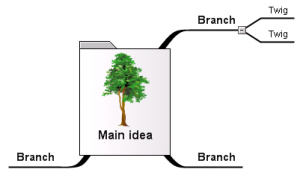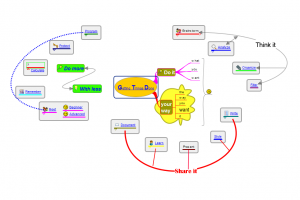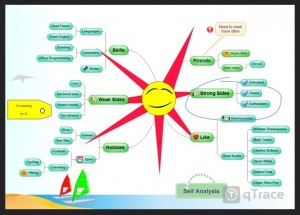Mind Map

A Mind Map is a powerful graphic technique which is used to visually outline information. Originated in the late 1960s by Tony Buzan Mind Maps are now used by millions of people around the world – from the very young to the very old – whenever they wish to use their minds more effectively!
A Mind Map is often created around a single word or text, placed in the center, to which associated ideas, words and concepts are added. Major categories radiate from a central node, and lesser categories are sub-branches of larger branches. Categories can represent words, ideas, tasks, or other items related to a central key word or idea.
A Powerful Approach to Note-Taking also known as Mind Mapping, Concept Mapping, Spray Diagrams, and Spider Diagrams. This provides a universal key to unlock the potential of the brain. It harnesses the full range of cortical skills – word, image, number, logic, rhythm, colour and spatial awareness – in a single, uniquely powerful manner. In so doing, it gives you the freedom to roam the infinite expanses of your brain. The Mind Map can be applied to every aspect of life where improved learning and clearer thinking will enhance human performance.
Mind mapping is a highly effective way of getting information in and out of your brain. Mind mapping is a creative and logical means of note-taking and note-making that literally „maps out“ your ideas.
All Mind Maps have some things in common. They have a natural organizational structure that radiates from the center and use lines, symbols, words, color and images according to simple, brain-friendly concepts. Mind mapping converts a long list of monotonous information into a colorful, memorable and highly organized diagram that works in line with your brain’s natural way of doing things.
One simple way to understand a Mind Map is by comparing it to a map of a city. The city center represents the main idea; the main roads leading from the center represent the key thoughts in your thinking process; the secondary roads or branches represent your secondary thoughts, and so on. Special images or shapes can represent landmarks of interest or particularly relevant ideas.
The Mind Map is the external mirror of your own radiant or natural thinking facilitated by a powerful graphic process, which provides the universal key to unlock the dynamic potential of the brain.
The five essential characteristics of Mind Mapping:
The main idea, subject or focus is crystallized in a central image.
The main themes radiate from the central image as ‚branches‘.
The branches comprise a key image or key word drawn or printed on its associated line.
Topics of lesser importance are represented as ‚twigs‘ of the relevant branch.
The branches form a connected nodal structure.
What do you need to make a Mind Map?
Because Mind Maps are so easy to do and so natural, the ingredients for your “Mind Map Recipe” are very few:
Blank unlined paper
Colored pens and pencils
Your Brain
Your imagination!
Mind Maps are more compact than conventional notes, often taking up one side of paper. This helps you to make associations easily, and generate new ideas.
More than this, Mind Mapping helps you break large projects or topics down into manageable chunks, so that you can plan effectively without getting overwhelmed and without forgetting something important.
A good Mind Map shows the „shape“ of the subject, the relative importance of individual points, and the way in which facts relate to one another. This means that they’re very quick to review, as you can often refresh information in your mind just by glancing at one. In this way, they can be effective mnemonics – remembering the shape and structure of a Mind Map can give you the cues you need to remember the information within it.
When created using colors and images or drawings, a Mind Map can even resemble a work of art!
Have you ever studied a subject or brainstormed an idea, only to find yourself with pages of information, but no clear view of how it fits together?
This is where Mind Mapping can help you.
Mind Mapping is a useful technique that helps you learn more effectively, improves the way that you record information, and supports and enhances creative problem solving.
By using Mind Maps, you can quickly identify and understand the structure of a subject. You can see the way that pieces of information fit together, as well as recording the raw facts contained in normal notes.
More than this, Mind Maps help you remember information, as they hold it in a format that your mind finds easy to recall and quick to review.
Example:
Self-Analysis Mind Map:
7 Steps to Making a Mind Map :
1. Start in the CENTRE of a blank page turned sideways. Why? Because starting in the centre gives your Brain freedom to spread out in all directions and to express itself more freely and naturally.
2. Use an IMAGE or PICTURE for your central idea. Why? Because an image is worth a thousand words and helps you use your Imagination. A central image is more interesting, keeps you focussed, helps you concentrate, and gives your Brain more of a buzz!
3. Use COLOURS throughout. Why? Because colours are as exciting to your Brain as are images. Colour adds extra vibrancy and life to your Mind Map, adds tremendous energy to your Creative Thinking, and is fun!
4. CONNECT your MAIN BRANCHES to the central image and connect your second- and third-level branches to the first and second levels, etc. Why? Because your Brain works by association. It likes to link two (or three, or four) things together. If you connect the branches, you will understand and remember a lot more easily.
5. Make your branches CURVED rather than straight-lined. Why? Because having nothing but straight lines is boring to your Brain.
6. Use ONE KEY WORD PER LINE. Why Because single key words give your Mind Map more power and flexibility.
7. Use IMAGES throughout. Why because each image, like the central image, is also worth a thousand words. So if you have only 10 images in your Mind Map, it’s already the equal of 10,000 words of notes!
Uses
Mind Maps are useful for:
• Brainstorming – individually, and as a group.
• Summarizing information, and note taking.
• Consolidating information from different research sources.
• Thinking through complex problems.
• Presenting information in a format that shows the overall structure of your subject.
• Studying and memorizing information.
Key Points
• Mind Mapping is an extremely effective method of taking notes.
• Not only do Mind Maps show facts, they also show the overall structure of a subject and the relative importance of individual parts of it.
• They help you to associate ideas, think creatively, and make connections that you might not otherwise make.
• Mind Maps are useful for summarizing information, for consolidating large chunks of information, for making connections, and for creative problem solving.
• To use Mind Maps effectively, make sure you print your words, use different colors to add visual impact, and incorporate symbols and images to further spur creative thinking.
• If you do any form of research or note taking, try experimenting with Mind Maps. You’ll love using them!
Mind Map Tools:
1. Freeplane,
2. FreeMind,
3. Coggle
4. MindMup and
5. XMind
Conclusion:
When you use Mind Maps on a daily basis, you will find that your life becomes more productive, fulfilled, and successful on every level. There are no limits to the number of thoughts, ideas and connections that your brain can make, which means that there are no limits to the different ways you can use Mind Maps to help you.
So, generate new ideas using Mind Maps…
References:
http://www.mindtools.com/pages/article/newCT_88.htm
http://en.wikipedia.org/wiki/Mind_map
http://www.mindtools.com/pages/article/newISS_01.htm
http://www.mindmapping.com/
http://freemind.sourceforge.net/wiki/index.php/Main_Page
http://www.mindmeister.com/demo/350930047?t=Nyt2j6YDK7
https://www.text2mindmap.com/
http://www.xmind.net/


